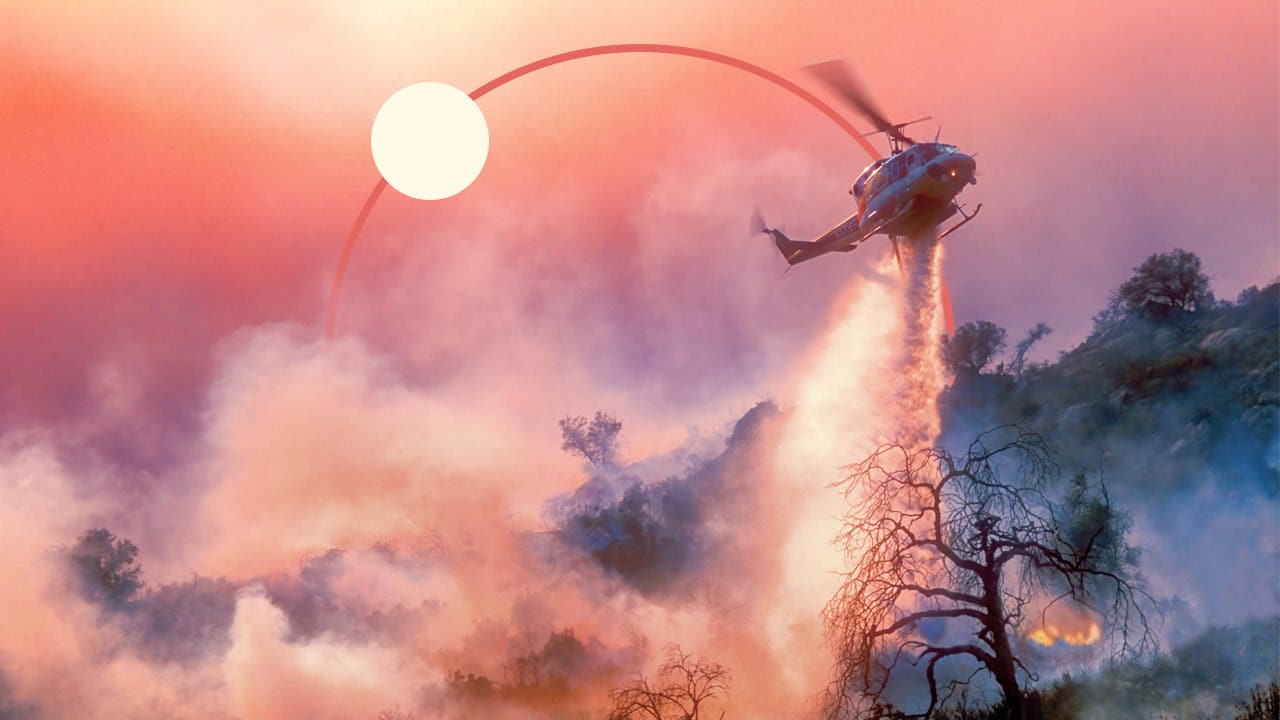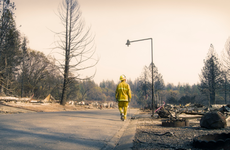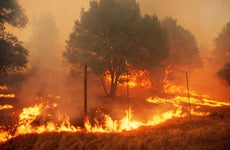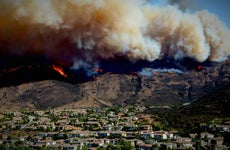2023 U.S. wildfire statistics

The Bankrate promise
At Bankrate, we strive to help you make smarter financial decisions. To help readers understand how insurance affects their finances, we have licensed insurance professionals on staff who have spent a combined 47 years in the auto, home and life insurance industries. While we adhere to strict , this post may contain references to products from our partners. Here's an explanation of . Our content is backed by Coverage.com, LLC, a licensed entity (NPN: 19966249). For more information, please see our .
Between 2022 and 2023, wildfires accounted for over $3.2 billion in damage across the United States. Areas in the west, like California, Nevada and Arizona, with long stretches of arid climate and little rain, are especially susceptible to wildfires. They can be devastating, growing quickly, taking out homes and entire communities and racking up billions of dollars in damage. Urban sprawl and climate change are two factors that increase the likelihood and frequency of wildfires across the country. Having the right homeowners insurance in place can be key to helping consumers offset the cost of wildfire damage. Here, we examine the most recent statistics and data for U.S. wildfires, including how to file a claim if your home is damaged by smoke or fire.
Key takeaways
- A wildfire is an uncontrolled, unpredictable and unplanned burn in an area of naturally ignitable vegetation. While prairies, forests and grasslands are standard wildfire zones, suburban areas backing up to wildlife are frequently impacted.
- Unless otherwise excluded, a typical homeowners policy covers damage from a fire to your dwelling, other structures and personal property. A renters insurance policy will cover damage to your personal property. The amount and type of insurance pay out depends on your provider and policy selection.
- Homes in regions with a high risk from wildfires might not qualify for a standard homeowners insurance policy.
Wildfire statistics
Bushfire, brushfire, forest fire, rural fire and wildland fire are different terms for wildfire—the region and characteristics of the fire determine the type of wildfire. According to the World Health Organization (WHO), wildfires are an increasing concern not only due to the loss of property involved but also its impact on air quality, crops, resources, transportation and health issues for animals and people. Most wildfires are caused by human activity such as unattended campfires and discarded cigarettes while some are caused by lava and lighting.
- 4.5 million U.S. homes are at high or extreme risk from wildfires, with over 2 million in California alone. (Verisk)
- There were 66,255 wildfires in 2022, which affected 7.5 million acres, compared to just 18,229 wildfires and 1,323,666 acres lost in 1983 when official record-keeping began. (NCEI)
- There was a 17 percent increase from 2019 to 2021 in U.S. wildfires and a 223 percent increase since 1983. (NIFC)
- Humans cause as many as 85 percent of wildfires, with the remaining 15 percent caused by lava and lightning. (U.S. Department of Interior)
- Wildfires, drought, and heatwaves accounted for $20.36 billion in economic losses and $8.69 billion in insurance losses in 2021. (Insurance Information Institute – Triple-I)
- To date in 2023, there have been 17,292 wildfires with over 498,820 acres burned. (NFIC)
The worst wildfires in U.S. history
The Insurance Information Institute (Triple-I) rated the costliest wildland fires in the United States. Based on its data, the top five costliest wildfires, all in California, each caused several billions of dollars in insured losses.
- Camp Fire, 2018: Total damages from the costliest U.S. wildfire of all time are estimated at $10 billion, roughly $10.75 billion in 2021 value. The fire burned 18,804 structures and 153,335 acres of woodland.
- Tubbs Fire, 2017: The Tubbs fire incurred $8.7 billion in estimated insured losses or about $9.56 billion by 2021 value. This electrical fire caused 36,807 acres of woodland to burn and 5,636 structures.
- Woolsey Fire, 2018: The Woolsey Fire cost $4.2 billion in estimated losses, or $4.56 million with inflation. There were 1,643 structures and 96,949 acres of woodland destroyed.
- Oakland Fire (Tunnel), 1991: This wildfire in the early 90s caused estimated losses of $1.7 billion, or $3.35 billion with 2021 inflation value. There were 2,900 structures and 1,600 acres of woodland damaged.
- Atlas Fire, 2017: The Atlas Fire cost about $3 billion in damages, or what would be $3.3 billion in 2021. The fire caused damage to 903 structures and burned 51,624 acres of woodland.
Wildfires in recent years
The National Interagency Fire Center offers year-over-year data for U.S. wildfires, although recordkeeping did not begin until 1983.
-
*North Carolina state lands are exempt from 2004 fires and acreage.Year Number of Fires Number of Acres Affected 2022 68,988 7,577,183 2021 58,985 7,125,643 2020 58,950 10,122,336 2019 50,477 4,664,364 2018 58,083 8,767,492 2017 71,499 10,026,086 2016 67,743 5,509,995 2015 68,151 10,125,149 2014 63,312 3,595,613 2013 47,579 4,319,546 2012 67,774 9,326,238 2011 74,126 8,711,367 2010 71,971 3,422,724 2009 78,792 5,921,786 2008 78,979 5,292,468 2007 85,705 9,328,045 2006 96,385 9,873,745 2005 66,753 8,689,389 2004 65,461 8,097,880* 2003 63,629 3,960,842 2002 73,457 7,184,712 2001 84,079 3,570,911 2000 92,250 7,393,493 1999 92,487 5,626,093 1998 81,043 1,329,704 1997 66,196 2,856,959 1996 96,363 6,065,998 1995 82,234 1,840,546 1994 79,107 4,073,579 1993 58,810 1,797,574 1992 87,394 2,069,929 1991 75,754 2,953,578 1990 66,481 4,621,621 1989 48,949 1,827,310 1988 72,750 5,009,290 1987 71,300 2,447,296 1986 85,907 2,719,162 1985 82,591 2,896,147 1984 20,493 1,148,409 1983 18,229 1,323,666
Wildfire suppression
Fires need fuel, heat and oxygen to burn. Wildfire suppression means to manage, modify, prevent or extinguish a wildfire. Several strategies are used to suppress wildfires, including creating control lines using prescribed burns or natural barriers like rocky slopes or large barren soil areas and removing the fire’s fuel source, such as using hand tools or heavy equipment to remove quick-burning vegetation. National Guard members can also be deployed to support efforts, providing air assistance for mapping the fire, dropping flame retardant and water, as well as offering assistance on the ground as firefighters and EMTs. The area’s landscape, plus fire and weather conditions, determine the method used.
The National Interagency Fire Center offers data on annual suppression costs for U.S. wildfires. The five-year average costs the Forest Service over $2 billion, while the cost to DOI agencies was more than $525 million. The total ten-year average is less, at around $1.9 billion, suggesting that the cost of suppressing these fires is going up over time. At nearly $4.4 billion, 2021 was the most expensive year for total fire suppression costs since record-keeping began in 1985, when the total annual costs topped out at just under $240 million.
Annual wildfire suppression costs
| Year | Forest Service | DOI Agencies | Total |
|---|---|---|---|
| 2021 | $3,741,000,000 | $648,000,000 | $4,389,000,000 |
| 2020 | $1,764,000,000 | $510,000,000 | $2,274,000,000 |
| 2019 | $1,150,000,000 | $440,000,000 | $1,590,000,000 |
| 2018 | $2,615,256,000 | $528,000,000 | $3,143,256,000 |
| 2017 | $2,410,165,000 | $508,000,000 | $2,918,165,000 |
| 2016 | $1,603,806,000 | $371,739,000 | $1,975,545,000 |
| 2015 | $1,713,000,000 | $417,543,000 | $2,130,543,000 |
Wildfire statistics by state
To best understand how wildfires affect the different regions of the U.S., this NIFC table shows the number of wildfires by cause and type in 2022.
-
State Human fires Lightning fires Total fires Total acres burned Number of fires Number of acres burned Number of fires Number of acres burned Alabama 1,916 39,583 794 1,392 2,710 40,975 Alaska 313 11,843 282 3,099,133 595 3,110,976 Arizona 939 71,535 493 52,629 1,432 124,165 Arkansas 1,881 38,751 22 277 1,903 39,028 California 7,585 250,394 299 58,892 7,887 309,287 Colorado 302 40,470 533 5,262 835 45,732 Connecticut 150 347 0 0 150 347 Delaware 7 79 0 0 7 79 District of Columbia N/A N/A N/A N/A N/A N/A Florida 2,251 101,472 533 63,302 2,784 164,774 Georgia 3,617 22,355 4 2,662 3,621 25,017 Hawaii 4 25,048 1 5 5 25,053 Idaho 509 230,898 579 205,834 1,088 436,733 Illinois 32 298 0 0 32 298 Indiana 49 1,643 0 0 49 1,643 Iowa 7 288 0 0 7 288 Kansas 64 80,089 3 3,926 67 84,015 Kentucky 1,278 59,198 2 1 1,280 59,199 Louisiana 1,255 24,449 4 26 1,259 24,475 Maine 709 409 21 16 730 425 Maryland 110 2,899 7 240 117 3,139 Massachusetts 1,180 1,749 12 7 1,192 1,756 Michigan 358 759 18 2,763 376 3,522 Minnesota 709 3,705 4 10 713 3,715 Mississippi 1,977 53,156 3 13 1,980 53,170 Missouri 136 4,968 0 0 136 4,968 Montana 1,395 50,582 692 86,927 2,087 137,509 Nebraska 5529 71,121 39 5,413 568 76,534 Nevada 305 20,921 201 37,480 506 58, 402 New Hampshire 89 370 14 11 103 381 New Jersey 1,165 15,532 0 0 1,165 15,532 New Mexico 453 847,283 295 12,622 748 859,906 New York 152 1,086 10 227 162 1,313 North Carolina 6,166 27,403 56 1,448 6,222 28,851 North Dakota 109 1,509 2 0 111 1,509 Ohio 724 3,063 0 0 724 3,063 Oklahoma 2,807 383,950 4 1,183 2,811 385,133 Oregon 1,143 56,201 974 399,881 2,117 456,082 Pennsylvania 943 2,549 8 39 951 2,588 Rhode Island 76 44 0 0 76 44 South Carolina 21 663 1 14 22 677 South Dakota 437 41,061 90 1,087 527 42,148 Tennessee 1,217 15,007 8 52 1,225 15,059 Texas 12,031 584,691 540 87,109 12,571 671,800 Utah 476 24,281 469 2,964 945 27,245 Vermont 77 83 9 0 86 83 Virginia 547 9,865 11 91 558 9,956 Washington 1,220 105,550 272 68,109 1,492 173,659 West Virginia 889 20,233 4 42 893 20,275 Wisconsin 923 881 0 0 923 881 Wyoming 267 19,866 176 5,880 443 25,766
Riskiest states for wildfires
California is by far the most at-risk state for wildfires in the U.S., with nearly triple the number of properties at-risk in 2022 as the second-highest state. While Texas had less than 717,000 at-risk properties, California had more than two million.
- California: 2,040,600
- Texas: 717,800
- Colorado: 373,900
- Arizona: 242,200
- Idaho: 175,000
These are the top at-risk states for wildfire in the U.S. based on the number of properties at extreme risk.
At-risk states
| Rank | State | Number of at-risk properties |
|---|---|---|
| 1. | California | 2,040,600 |
| 2. | Texas | 717,800 |
| 3. | Colorado | 373,900 |
| 4. | Arizona | 242,200 |
| 5. | Idaho | 175,000 |
| 6. | Washington | 155,500 |
| 7. | Oklahoma | 153,400 |
| 8. | Oregon | 147,500 |
| 9. | Montana | 137,800 |
| 10. | Utah | 136,000 |
California wildfires
California has made a name for itself with wildfires. CAL FIRE and its partner agencies offer current and past U.S. wildfire season statistics. Wildfires in 2021 burned almost 2.6 million acres, damaged or destroyed 3,629 structures and caused three fatalities. There was a slowdown in destruction from California wildfires in 2022 with 362,455 acres burned, 104 structures damaged, 772 structures destroyed and sadly, nine civilian fatalities.
The 2021 Dixie fire burned from July 13 to October 25 and encompassed five counties, making it the largest single wildfire and the second-largest in the history of California. It damaged 95 structures, destroyed 1,329 and caused one firefighter fatality. There were 725 personnel involved in containing the Dixie Fire.
As of the publishing of this article, 2023 is forecasted to be an average wildfire season due to the wet winter and spring. Currently, there have been 1,392 wildfires burning through 2,670 acres, with zero fatalities or structure damage.
Fire damage restoration
The average home insurance policy covers the structure of your home, as well as personal belongings and additional living expenses, should you be affected by a wildfire. Those with renters insurance, condo insurance, and manufactured or mobile home insurance should check their policies to ensure adequate coverage in case of a wildfire.
However, if you live in a high-risk area for wildfires, such as California, you could be denied coverage. In this case, the California FAIR plan is one option that offers basic coverage for high-risk customers who typically cannot find standard home insurance. After a record year of wildfires in 2018, it was estimated that 350,000 California home and business owners could not purchase adequate property and casualty insurance because of the increased risk that providers were facing. Significant issues were created for homeowners trying to satisfy mortgage requirements of home insurance.
Many home insurance policies cover damage from the wildfire as well as smoke damage. If you receive smoke damage, you can file a claim with your insurance company. Most carriers offer several ways to file a claim, including online, over the phone and through a mobile app. Once the claim is filed, an insurance adjuster will be assigned to your case, who will provide you with next steps. Be aware that the claims process can move slowly when there are a large number of structures and vehicles affected.
You may wish to call a remediation company, who can start the process of repairing your home after smoke or fire damage while you wait for next steps from the insurance company. The company can work with you to save damaged items. You should consider taking photos and video of the damage and retain receipts for any out-of-pocket costs that could be covered as part of your homeowners claim.
Frequently asked questions
-
-
The Center for Disease Control and Prevention (CDC) recommends having a clear wildfire preparation plan for children, individuals with medical conditions, pets and livestock. Make sure to be familiar with different routes to leave your home and local shelter options. Emergency supplies and go-bags should be on hand with 72-hours worth of reserves. If possible, create a “clean-room” in your home — a room with few windows and doors with a portable air cleaner — for a fire situation that allows you to remain in your home as long as you can maintain safe air quality.
-
Wildfire season happens at different times across the nation and can come early or late depending on how wet the winter was and how dry the summer will be. For example, AccuWeather predicts that springtime in California poses a low wildfire threat. However, August and September will be peak wildfire season for Northern California and September to November will be peak wildfire season for Central and Southern California. Parts of Idaho, Montana, northern Nevada, Oregon and Washington could see wildfires as early as June and may hit peak wildfire season between July and September. Check with your local fire department to know when to be on guard for wildfires in your region.
-
Staying alert and prepared is the best way to keep safe during a wildfire—if a fire is in your area, receive constant alerts in case you need to leave. Some basic necessities to keep readily available are a crank or battery-powered radio, N-95 mask, charged cell phone, flashlight, sturdy shoes and water. When it is time to evacuate, make sure everyone is wearing long sleeve shirts and pants made from cotton or other flame-resistant materials to protect their skin and goggles or glasses to protect their eyes.
-
Related Articles


What you need to know about wildfire insurance in California

